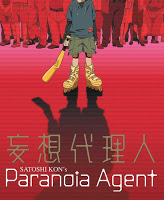Dernière mise à jour : août 18th, 2015 at 10:27 am
“Paranoia Agent” is a Japanese animated TV serie created in 2004 by director Satoshi Kon and produced whithin Madhouse studio. The serie follows several characters around an investigation carried out by two police detectives to stop the always more violent and frequent attacks by a mysterious and elusive roller-skating kid the medias nicknames Lil’ Slugger.
Lil’ Slugger actually is a lie born in the mind of star designer Tsukiko when in her teenagehood she unintentionally let her puppy die. Instead of taking responsability for the death, she invented a fake offender wearing inline skates and armed with a bat. Then, as the coming release of a animated TV serie starring her mascot Maromi accompanies an unprecedented media and folk frenzy, and as her employer pushes her to create a new popular character, Tsukiko summons Lil’ Slugger once again to freed her from that professional pressure, thus giving life to a character which will set in the collective unconscious as Maromi’s negative double, whorshipping the first fuelling their fear for the other, and vice versa. In the climax of the serie, Tsukiko’s creations eventually fight each other like two Godzillas, in the tradition of Japanese monster movies.
- the serie’s social scope resonates in other Kon’s movies, most notably in “Tokyo Godfathers” (2003), which features homeless characters like one of “Paranoia Agent”‘s main character, the old lady who witnesses Lil’ Slugger’s rebirth in the first episode.
- confusion between reality and fiction is a major theme which Kon renews from film to film. In “Paranoia Agent”, that theme even becomes the main narrative feature as Lil’ Slugger’s attacks increase in number and tamper with the natural order. In the climax of episode #7, when the copycat arrested in episode #4 and pushed to his limits during interrogation himself becomes a victim of Lil’ Slugger, his supernatural nature is finally revealed to the powerless policemen as they watch him fade away before them after committing his murder, the first in the serie. His next appearances become always more bizarre and paranormal.
- in Kon’s movies, madness often manifests itself through personality disorder, which the director visually illustrates by having as many character on screen as there are personas. Such visual trick was already used in the climax of “Perfect Blue”. Here however, with its main character living a double life as a sweet and timid teacher assistant by day and torrid prostitute by night, episode #3 (“Double lips”) heralds Kon’s 2006 movie “Paprika”. Not only do these two personnalities have very opposite looks, they also communicate with one another through the answering machine, which slowly forces the viewer to wonder which personnality actually is the original one.
- more extreme variation of that previous theme, the otaku phenomenon was already a major element in 1998 “Perfect Blue”. In “Paranoia Agent”, not only does Lil’ Slugger’s young copycat believes himself to be in a video game (hilarious episode #5 (“The holy warrior”), police detective Maniwa, depicted in that same episode to be a connoisseur of role-playing games, starts to show obsessive behaviour after he loses his job (ep.#7, “MHz”) until he finally acts as a masked vigilante (ep.#12, “Radar man”). Funny in his appearance (his self-made costume), posture (he talks like a knight) or even in his hallucinations (he believes his umbrella to be a sword), his attitude is the result of a sudden and quite pathetic break from reality. Nevertheless, he is the one who carries on the investigation and discovers Lil’ Slugger’s true nature. Also, quite inexplicably, his own hallucinations aids him, particularly some sexy collectible mini statues, modern-time fairies who provide him with clues and assistance.
Crew
Directed by : Satoshi Kon
Written by : Seishi Minakami
Animation : studio Madhouse
Character design : Masaji Ando
Music : Susumu Hirasawa
2004 – 13×25 min
Cast
Lil’ Slugger : Daisuke Sakaguchi
Tsukiko Sagi : Mamiko Noto
Maromi : Haruko Momoi
Ikari : Shozo Iizuka
Maniwa : Toshihiko Seki
Harumi Chono : Kotono Mitsuishi
 Bulles de Culture Sur Bulles de Culture, chaque jour, la culture sort de sa bulle !
Bulles de Culture Sur Bulles de Culture, chaque jour, la culture sort de sa bulle !


